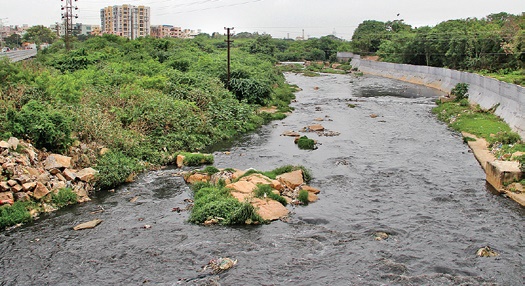Eeshna Dashottar, Pune
The Telangana state government working on the rejuvenation of the Musi River, has reported that over 10,000 structures lying on the bed and buffer zones of the river will be demolished for the project.
Formulated to restore the surrounding ecosystem and develop urban spaces around it, the Musi Riverfront Development Project (MRDP) was introduced by the Telangana state government. To achieve this, the government planned to set up recreational spots, parks, and other leisure areas around the riverbed. In order to go ahead with the plans, the state government will have to take the measure of demolishing all the constructions that fall under the planned area near the Musi River. Along the 55-kilometer-long course of the Musi River, the region within 50 meters on both sides of it has been denoted as the buffer zone by the Irrigation Department. Structures in this zone may be demolished as per the plans and requirements of the project.
According to a survey conducted by the Revenue Department in and around the river, it has been found that there are 2,116 constructions on the riverbed and 7,850 in the buffer zone. These include heavily inhabited areas, as well. The individual houses on the riverbed, excluding spaces such as tombs, chillas, dhobi ghats, etc., have been recorded to be around 1,500 to 1,600.
With residential complexes and houses coming under the demolition plan, people have begun raising concerns over the future of their living spaces and the expected compensation that the state government should provide them in case of demolition.
The spaces that fall under the buffer zone have been found to be built on patta land, which means that there are clear legal ownership documents available for these structures. Because of this, these structures cannot be called encroachments. So, a proper land acquisition procedure will also have to be applied by the government for going with the demolition plan. The government is looking into rehabilitation of the dwellers from these areas as a large proportion of them come from poor backgrounds. The number of people to be displaced has not been determined yet. Instances of multiple inhabitants in small complexes, like in the hugely inhabited areas of Chaderghat and Patel Nagar, further increase the number of people to be displaced.
Minister in charge of Hyderabad, Ponnam Prabhakar, visited two areas with double-bedroom complexes on September 21 to search for suitable accommodation for the displaced. The Minister also took a look at the vacant units in the 2BHK complex at Chanchalguda crossroads and Vanasthalipuram.
The minister has promised proper rehabilitation for the displaced families. Along with that, he also mentioned that women from these families will be given self-employment opportunities through the Indira Mahila Shakti Scheme. It is yet to be seen how effectively the displacement and demolition will be taken forward amidst the plans for rejuvenation.
